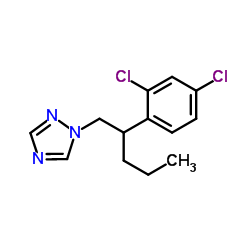penconazole

penconazole structure
|
Common Name | penconazole | ||
|---|---|---|---|---|
| CAS Number | 66246-88-6 | Molecular Weight | 284.184 | |
| Density | 1.3±0.1 g/cm3 | Boiling Point | 415.3±55.0 °C at 760 mmHg | |
| Molecular Formula | C13H15Cl2N3 | Melting Point | 57.6-60.3ºC | |
| MSDS | Chinese USA | Flash Point | 204.9±31.5 °C | |
| Symbol |



GHS07, GHS08, GHS09 |
Signal Word | Warning | |
Use of penconazolePenconazole is a typical triazole fungicide, and mainly applied on apples, grapes, and vegetables to control powdery mildew. Penconazole inhibits sterol biosynthesis in fungi. Penconazole decrease AChE activity in the cerebrum and cerebellum of rats[1][2]. |
| Name | penconazole |
|---|---|
| Synonym | More Synonyms |
| Description | Penconazole is a typical triazole fungicide, and mainly applied on apples, grapes, and vegetables to control powdery mildew. Penconazole inhibits sterol biosynthesis in fungi. Penconazole decrease AChE activity in the cerebrum and cerebellum of rats[1][2]. |
|---|---|
| Related Catalog | |
| In Vivo | Penconazole (67 mg/kg; i.p.; every 2 days during 9 days) induces oxidative stress in rat cerebrum and cerebellum tissues[2]. Penconazole has the ability to induce oxidative damage in the brain of adult rats, as evidenced by an increase of lipid peroxidation and protein oxidation, in addition to the perturbations in the enzymatic and nonenzymatic antioxidant status. Penconazole also affects the cholinergic system, activities of membrane-bound ATPases, and brain histoarchitecture. Penconazole is a potential neurotoxicant pesticide that exerts its neurotoxic effects via the generation of oxidative stress. Penconazole causes a significant inhibition of AChE activity in the cerebrum (11%) and cerebellum (25%) of adult rats[2]. Animal Model: Twelve male Wistar rats[2] Dosage: 67 mg/kg Administration: I.p.; every 2 days during 9 days Result: A significant increase was obtained in the absolute and relative weights of the cerebrum and cerebellum, respectively. |
| References |
| Density | 1.3±0.1 g/cm3 |
|---|---|
| Boiling Point | 415.3±55.0 °C at 760 mmHg |
| Melting Point | 57.6-60.3ºC |
| Molecular Formula | C13H15Cl2N3 |
| Molecular Weight | 284.184 |
| Flash Point | 204.9±31.5 °C |
| Exact Mass | 283.064301 |
| PSA | 30.71000 |
| LogP | 3.66 |
| Vapour Pressure | 0.0±1.0 mmHg at 25°C |
| Index of Refraction | 1.602 |
| Storage condition | 0-6°C |
CHEMICAL IDENTIFICATION
HEALTH HAZARD DATAACUTE TOXICITY DATA
|
| Symbol |



GHS07, GHS08, GHS09 |
|---|---|
| Signal Word | Warning |
| Hazard Statements | H302-H361d-H410 |
| Precautionary Statements | P201-P273-P301 + P312 + P330-P308 + P313-P391-P501 |
| Personal Protective Equipment | Eyeshields;Gloves;type N95 (US);type P1 (EN143) respirator filter |
| Hazard Codes | Xi |
| Safety Phrases | S22-S24/25 |
| RIDADR | UN 3077 9 / PGIII |
| RTECS | XZ4615000 |
| HS Code | 2933990015 |
|
~% 
penconazole CAS#:66246-88-6 |
| Literature: US4556717 A1, ; |
| Precursor 1 | |
|---|---|
| DownStream 0 | |
| HS Code | 2933990016 |
|---|---|
| Summary | 2933990016 1-(2-(2,4-dichlorophenyl)pentyl)-1h-1,2,4-triazole。supervision conditions:s(import or export registration certificate for pesticides)。VAT:17.0%。tax rebate rate:9.0%。MFN tarrif:6.5%。general tariff:20.0% |
|
The dissipation of three fungicides in a biobed organic substrate and their impact on the structure and activity of the microbial community.
Environ. Sci. Pollut. Res. Int. 20(4) , 2546-55, (2013) Biopurification systems (BPS) have been introduced to minimise the risk for point source contamination of natural water resources by pesticides. Their depuration efficiency relies mostly on the high b... |
|
|
Enantiomeric separation of triazole fungicides with 3-μm and 5-μml particle chiral columns by reverse-phase high-performance liquid chromatography.
Chirality 23(6) , 479-86, (2011) This study used chiral columns packed with 3-μm and 5-μm particles to comparatively separate enantiomers of 9 triazole fungicides, and Lux Cellulose-1 columns with chiral stationary phase of cellulose... |
|
|
Biological monitoring of pesticide exposures in residents living near agricultural land.
BMC Public Health 11 , 856, (2011) There is currently a lack of reliable information on the exposures of residents and bystanders to pesticides in the UK. Previous research has shown that the methods currently used for assessing pestic... |
| topasmz |
| (RS)-1-[2-(2,4-dichlorophenyl)pentyl]-1H-1,2,4-triazole |
| EINECS 266-275-6 |
| PENCONAZOL |
| T5NN DNJ A1Y3&R BG DG |
| 1-[2-(2,4-Dichlorophenyl)pentyl]-1H-1,2,4-triazole |
| onmex |
| MFCD00078737 |
| 1-[2-(2,4-Dichlorophenyl)-n-pentyl]-1H-1,2,4-triazole |
| Topas |
| 1-(2,4-Dichloro-β-propylphenethyl)-1H-1,2,4-triazole |
| topaze |
| 1H-1,2,4-Triazole, 1-[2-(2,4-dichlorophenyl)pentyl]- |
| topazec |
| penconazole |
| topasc |
| Pine gel |
| rac-1-[(2R)-2-(2,4-dichlorophenyl)pentyl]-1H-1,2,4-triazole |
![1,2-Hydrazinedicarboxaldehyde, 1-[2-(2,4-dichlorophenyl)pentyl] structure](https://image.chemsrc.com/caspic/056/89586-77-6.png)